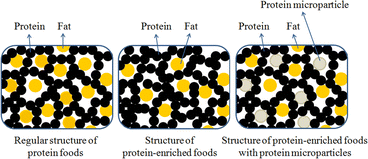Protein micro-structuring as a tool to texturize proteinfoods
Abstract
Structuring

- This article is part of the themed collection: International Symposium on Food Rheology and Structure
Maintenance work is planned for Wednesday 1st May 2024 from 9:00am to 11:00am (BST).
During this time, the performance of our website may be affected - searches may run slowly and some pages may be temporarily unavailable. If this happens, please try refreshing your web browser or try waiting two to three minutes before trying again.
We apologise for any inconvenience this might cause and thank you for your patience.
* Corresponding authors
a Top Institute Food and Nutrition, NieuweKanaal 9A, 6709 PA Wageningen, The Netherlands
b
Food Process Engineering Group, Wageningen University, Bomenweg 2, 6703 HD Wageningen, The Netherlands
E-mail:
atzejan.vandergoot@wur.nl
Fax: +31 317 482237
Tel: +31 317 480852
c Biosystem Engineering Division, Dept. of Mechanical & Biosystem Engineering, Bogor Agricultural University, P.O. Box 220, Bogor 16002, Indonesia
Structuring

 Please wait while we load your content...
Something went wrong. Try again?
Please wait while we load your content...
Something went wrong. Try again?
N. Purwanti, J. P. C. M. Peters and A. J. van der Goot, Food Funct., 2013, 4, 277 DOI: 10.1039/C2FO30158J
To request permission to reproduce material from this article, please go to the Copyright Clearance Center request page.
If you are an author contributing to an RSC publication, you do not need to request permission provided correct acknowledgement is given.
If you are the author of this article, you do not need to request permission to reproduce figures and diagrams provided correct acknowledgement is given. If you want to reproduce the whole article in a third-party publication (excluding your thesis/dissertation for which permission is not required) please go to the Copyright Clearance Center request page.
Read more about how to correctly acknowledge RSC content.
 Fetching data from CrossRef.
Fetching data from CrossRef.
This may take some time to load.
Loading related content
